America’s Cup Ruling Could Severely Impact San Diego’s Economy
- Share via
SAN DIEGO — If it stands up to appeal, a New York judge’s decision giving the America’s Cup to New Zealand will deprive San Diego of the estimated $1.2 billion the 1991 defense was expected to generate.
As the third-largest sporting event in the world after the Olympic Games and the World Cup soccer championships, the America’s Cup would have drawn hundreds of thousands of visitors to San Diego, spending an average $150 a day each in food and lodging for a total of $369 million, according to a study completed in late 1987 by CIC Research of San Diego.
The 20 or more racing syndicates expected to participate in the races were expected to spend $90 million on food, housing, services and other purchases over the two-year period preceding the race. Various public and governmental bodies were projected to spend $85 million in building the racing and spectator facilities.
All told, about 9,000 jobs would have been generated by the race, the CIC study said.
Just as important, the race would have focused worldwide attention on the area, stimulating future tourism and business activity, said Max Schetter, research director at the Greater San Diego Chamber of Commerce.
“It’s quite a blow to the region,” Schetter said. “It’s quite a shock, and judging from the people I’ve talked to, almost totally unexpected.”
Some money has been spent already by local businesses and government agencies in anticipation of the race. The San Diego port district is among the losers: it spent $300,000 in engineering studies and significant staff hours planning for the event, said Don Nay, the port director.
“We’ve been waiting to go full-bore in marketing the race until we knew the outcome of the legal challenge,” said Al Reese, spokesman for the San Diego Convention and Visitors Bureau.
The bureau had planned an aggressive campaign to market San Diego tourism in countries with syndicates mounting America’s Cup challenges, Reese said.
The decision’s most immediate, damaging effect could be to the boatyards ringing San Diego Bay and Mission Bay that had hoped to be host to the 20 or more syndicates expected to take part in the 1991 America’s Cup.
“All of the small boatyards in San Diego spent an enormous amount of money” preparing for the 1991 Cup defense, according to John Sawicki, a Coronado boatyard owner. “And they’re all left holding the bag right now.”
In preparation for the 1991 event, the yards have funded engineering and architectural studies to determine the needs of those syndicates. Sawicki said he had spent an estimated $20,000 on studies at his Coronado boatyard and made a $20,000 donation to the America’s Cup Task Force.
San Diego charter boat owners, however, did not view the 1991 races as a sure economic boon, in part because the disappointing business generated by last September’s races.
“(They) had a fairly limited impact on the fleet,” said San Diego Sportfishing Council spokeswoman Catherine Miller.
Point Loma Sportfishing planned to use four of its boats to carry race observers during last year’s races between New Zealand and the United States.
“But there wasn’t much interest, and we only ended up using one boat,” Hecht said.
In anticipation of the San Diego defense in 1991, Australian financier and yachtsman Alan Bond last December bought a 75% interest in the Kona Kai Club and Kona Inn hotel and resort on Shelter Island on San Diego Bay. He then announced plans to be host of the Australian syndicate on the site, as well as build a $50-million, 318-room addition to the property.
Bill De Leeuw, a minority owner with Bond of the property, said the expansion will continue whether the America’s Cup is held in San Diego or not.
More to Read
Inside the business of entertainment
The Wide Shot brings you news, analysis and insights on everything from streaming wars to production — and what it all means for the future.
You may occasionally receive promotional content from the Los Angeles Times.










